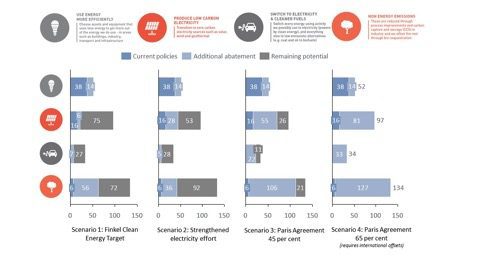A new report released by ClimateWorks Australia today shows Australia’s electricity sector needs to deliver a much greater cut than the 28 per cent emissions reduction analysed for the Finkel Review if we are to meet our 2030 target and put the country on a trajectory to net zero emissions by 2050.
At the upcoming COAG Energy Ministers meeting this Friday it is important that Australian governments not simply adopt the recommendations from the Finkel Review, but agree on additional policy to drive energy efficiency, demand side response and a steeper emissions reduction trajectory for the electricity sector, in line with the Paris Climate Agreement.
Closing the 2030 emissions reduction gap
The latest government emissions projections predict that Australia’s emissions will grow from 543 MtCO2e in 2016 (Climate Works article here)
If the impact of existing policies (such as the National Energy Productivity Plan, the phase down of HFCs and state renewable energy targets), are taken into account in the projections, it is estimated emissions could drop to 531 MtCO2e by 2030.
This still leaves an 82 MtCO2e gap towards the minimum emissions reduction target of 26 percent below 2005 levels.
Our report Power Up: Australia’s electricity sector can and should do more to deliver on our climate commitments models four scenarios with differing levels of emissions reductions undertaken in the electricity sector and the implications this has for the level of effort required across other sectors to meet our current 2030 target as well as achieving net zero emissions by 2050.
The work draws on ClimateWorks’ earlier research, the Pathways to Deep Decarbonisation in 2050 undertaken in partnership with Australian National University which has shown that we can reach net zero emissions by 2050 while continuing to grow the economy.
The report shows that there is more than enough potential for emissions reductions in Australia to fill the gap, and to meet more ambitious emissions reductions in line with our Paris commitment.
In particular, Australia’s electricity sector can cut emissions by up to 60 per cent below 2005 levels by 2030.
This is nearly six times more abatement than what is currently expected to be captured by current policies, and could by itself fill the whole emissions reduction gap.

New modelling shows electricity sector should do more than a proportionate effort to achieve cost effective emission cuts
The first scenario modelled in the report found that if the electricity sector only achieved a 28 per cent emissions reduction, in line with the Finkel analysis, then only 6 MtCO2e of abatement would be realised, leaving most of the effort to more costly sectors.
New policy would be required to bring forward all of the energy efficiency opportunities we have identified to 2030, plus 40 per cent of the technical potential to reduce emissions through fuel switching, electrification and action on non-energy emissions in the buildings, transport, industry, waste and land sectors.
To put this in perspective, to obtain this level of emissions reductions from the land sector we would need to increase afforestation over three times the amount estimated to be delivered through the federal government’s Emission Reduction Fund in 2018, its peak year.
If the share of renewables increases from 40 to 50 per cent by 2030, as modelled in our second scenario, then this could enable the electricity sector to achieve double the abatement.
Modelling by CSIRO and ENA has shown this is achievable while maintaining the security, reliability and affordability of the electricity system, even delivering cost benefits compared to a business-as-usual scenario. (Energy networks report here)
And this means other more costly sectors elsewhere in the economy would be required to deliver nearly a third less abatement.
Both those scenarios use 94 per cent of the Climate Change Authority’s recommended carbon budget to 2050. The required sharper emissions reductions post 2030 would risk highly disruptive structural and economic adjustments for Australia.
Economic analysis (Stern 2007; Stern N 2007, The Economics of Climate Change: The Stern Review, Cambridge University Press, Cambridge, UK) shows that there are costs to inaction and delay, including lost commercial opportunities.
In our third and fourth scenarios, we model national emissions reduction targets in line with the Climate Change Authority’s recommended trajectory, between 45 and 65 percent emissions reduction by 2030.
This requires Australia achieving a 45 to 60 per cent reduction in emissions from the electricity sector by 2030. In these scenarios, the levels of renewable energy reach 50 and 70 per cent respectively in 2030 and coal exits the system after a 40-year lifespan – 10 years earlier than assumed for analysis in the Finkel Review.
Our report shows further policy is required to deliver on Australia’s current 2030 target under any scenarios, but even more ambition is needed if we are to deliver on a 2030 target that is aligned with delivering on the Paris Agreement.

Amandine Denis-Ryan is the ClimateWorks Australia Head of Research.








